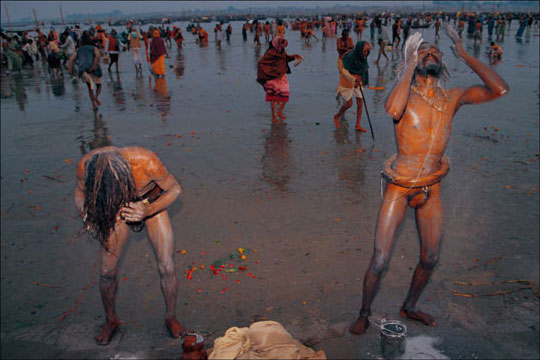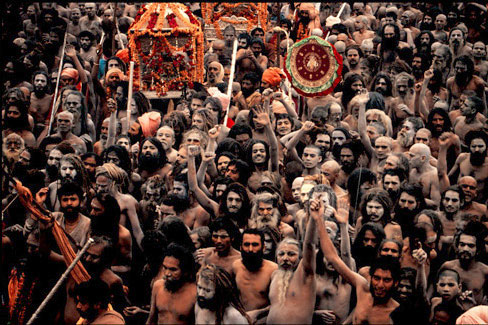In Hinduism, sadhu is a common term for an ascetic or practitioner of yoga (yogi) who has given up pursuit of the first three Hindu goals of life: kama (pleasure), artha (wealth and power) and even dharma (duty). The sadhu is solely dedicated to achieving moksha (liberation) through meditation and contemplation of God. Although the term Sadhu has its roots in Hinduism it is also used for followers of other religions, if they live a Sadhu life. There are Sadhus in Sikhism as well.
Vedic textual data suggest that asceticism in India - in forms similar to that practiced by sadhus today - dates back to 1500 BCE; the present-day sadhus of India likely represent the oldest continuous tradition of monastic mystical practice in the world.
http://en.wikipedia.org/wiki/Sadhu

Khumbha Mela, a bathing festival held at the sites of Prayaga (Allahabad), Haridwar, Nasik, and Ujjain on a rotating basis every four years. At Prayag, where the Yamuna River joins the Ganga, that the largest number of human beings in history gathered-15 million on Februray 6, 1998. It is said that the nectar of immortality was spilled on these sites during an ancient battle between the gods and the demons. Therefore, millions of people descend on these sites to bathe at the auspicious moments, to socialize, and to celebrate. Here two Sadhus bathe in the foreground while lay people come from bathing in the background. The sadhus wear wooden chastity belts.

Naga sadhus march as brothers in spirit on their way back from bathing.
Other images of sadhus
http://www.asianart.com/exhibitions/sadhus/index.html#1
Vedic textual data suggest that asceticism in India - in forms similar to that practiced by sadhus today - dates back to 1500 BCE; the present-day sadhus of India likely represent the oldest continuous tradition of monastic mystical practice in the world.
http://en.wikipedia.org/wiki/Sadhu

Khumbha Mela, a bathing festival held at the sites of Prayaga (Allahabad), Haridwar, Nasik, and Ujjain on a rotating basis every four years. At Prayag, where the Yamuna River joins the Ganga, that the largest number of human beings in history gathered-15 million on Februray 6, 1998. It is said that the nectar of immortality was spilled on these sites during an ancient battle between the gods and the demons. Therefore, millions of people descend on these sites to bathe at the auspicious moments, to socialize, and to celebrate. Here two Sadhus bathe in the foreground while lay people come from bathing in the background. The sadhus wear wooden chastity belts.

Naga sadhus march as brothers in spirit on their way back from bathing.
Other images of sadhus
http://www.asianart.com/exhibitions/sadhus/index.html#1
